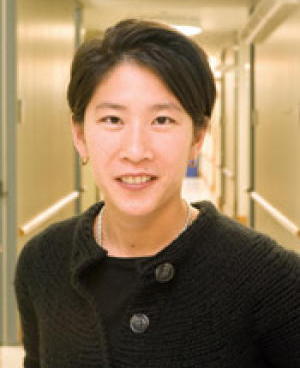Teri Odom's Particles Kill Cancer Cell Nuclei
By wchung | 23 Dec, 2025
Teri Odom has developed a “gold nanostar” that efficiently delivers drug particles directly to the nuclei of cancer cells.
Teri Odom’s Northwestern University research group has developed a “gold nanostar” that efficiently delivers drug particles directly to the nuclei of over a dozen type of cancer cells.
“Our drug-loaded gold nanostars are tiny hitchhikers,” said Odom. “They are attracted to a protein on the cancer cell’s surface that conveniently shuttles the nanostars to the cell’s nucleus. Then, on the nucleus’ doorstep, the nanostars release the drug, which continues into the nucleus to do its work.”
Odom’s nanostars are made of gold molecules using biocompatible synthesis. They are about 25 nanometers wide and are shaped with five to 10 points for a large surface area on which can be attached about 1,000 drug molecules. The surface of the gold nanostars stabilize the drug, allowing the use of smaller amounts than would be needed using free molecules.
Odom’s study used a single-stranded DNA aptamer called AS1411 which is attracted to and binds to nucleolin, a protein overexpressed in cancer cells. Nucleolins shuttle back and forth between a cell’s surface and the nucleus. The drug-loaded gold nanostars attach themselves to nucleolins and catch a ride to the surface of the nucleus. Once they reach their destination, ultrafast pulses of laser light cleaves the DNA aptamers from the nanostars, freeing the drug molecules to enter the nucleus and bring about the cell’s destruction.
A key advantage of the gold nanostars is that they release the drug molecules far more easily than other nanoparticles, obviating the need for them to pass through the nuclear membrane.
Because of the need to hit the nanostars with flashes of laser light from external sources, Odom feels her technique would be particularly useful for tumors like skin and breast cancer which are close to the skin’s surface. The gold nanostars may also be useful to surgeons seeking to eradicate stray cancer cells surrounding a tumor that has been excised.
Odom’s group is also the first to use electron microscopy to image nanoparticles interacting with cancer tumors. They saw that when the DNA aptamers were delivered and released, the shape shape of the cancer cell nucleus changed from a smooth ellipsoid into a highly irregular shape with deep folds. This shape change was found to accompany the death of the cancer cells.
Odom’s group had conducted the study on human cervical and ovarian cancer cells, but found later that the same results could be achieved on 12 other lines of cancer cells.
“All cancer cells seem to respond similarly,” she said. “This suggests that the shuttling capabilities of the nucleolin protein for functionalized nanoparticles could be a general strategy for nuclear-targeted drug delivery.”
The study was supported by the National Institutes of Health and was published in the journal ACS Nano.
Teri W. Odom is the Board of Lady Managers of the Columbian Exposition Professor of Chemistry in the Weinberg College of Arts and Sciences and a professor of materials science and engineering in the McCormick School of Engineering and Applied Science of Northwestern University. She graduated Phi Beta Kappa with a bachelors in chemistry from Stanford University in 1996, followed by a PhD in chemical physics from Harvard in 2001. She conducted post-doctoral research at Harvard from 2001 to 2002.
Odom has a long list of honors and awards including Radcliffe Institute for Advanced Study Fellow (Hrdy Fellow) at Harvard (2011), Defense Science Study Group Member (2010), MRS Outstanding Young Investigator Award (2009) and the NIH Director’s Pioneer Award (2008).

Northwestern University researcher Teri Odom has developed a highly effective drug delivery vehicle for targeting the nuclei of cancer cells.
Asian American Success Stories
- The 130 Most Inspiring Asian Americans of All Time
- 12 Most Brilliant Asian Americans
- Greatest Asian American War Heroes
- Asian American Digital Pioneers
- New Asian American Imagemakers
- Asian American Innovators
- The 20 Most Inspiring Asian Sports Stars
- 5 Most Daring Asian Americans
- Surprising Superstars
- TV’s Hottest Asians
- 100 Greatest Asian American Entrepreneurs
- Asian American Wonder Women
- Greatest Asian American Rags-to-Riches Stories
- Notable Asian American Professionals

